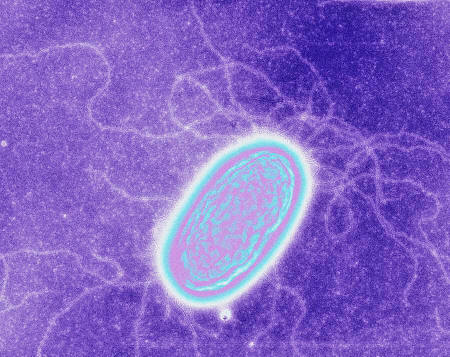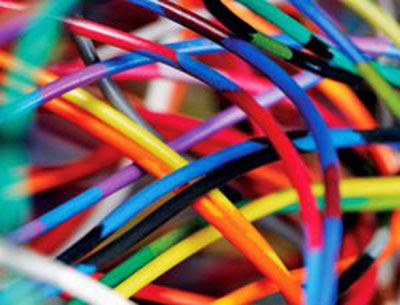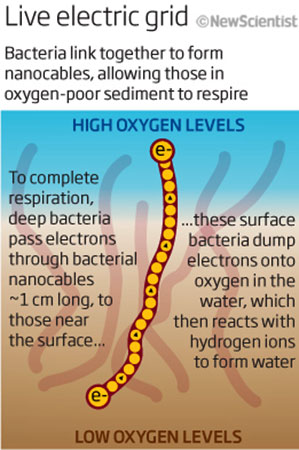|
Unlike any other life on Earth, these extraordinary bacteria use energy in its purest form - they eat and breathe electrons - and they are everywhere
STICK an electrode in the ground, pump electrons down it, and they will come: living cells that eat electricity.
We have known bacteria to survive on a variety of energy sources, but none as weird as this. Think of Frankenstein's monster, brought to life by galvanic energy, except these "electric bacteria" are very real and are popping up all over the place.
Unlike any other living thing on Earth, electric bacteria use energy in its purest form - naked electricity in the shape of electrons harvested from rocks and metals.
We already knew about two types, Shewanella and Geobacter.
Geobacter - a current favourite (Image: Derek Lovley/SPL)
Now, biologists are showing that they can entice many more out of rocks and marine mud by tempting them with a bit of electrical juice.
Experiments growing bacteria on battery electrodes demonstrate that these novel, mind-boggling forms of life are essentially eating and excreting electricity. That should not come as a complete surprise, says Kenneth Nealson at the University of Southern California, Los Angeles.
We know that life, when you boil it right down, is a flow of electrons:
Our cells break down the sugars, and the electrons flow through them in a complex set of chemical reactions until they are passed on to electron-hungry oxygen.
In the process, cells make ATP (adenosine triphosphate), a molecule that acts as an energy storage unit for almost all living things.
Moving electrons around is a key part of making ATP.
In most living things, the body packages the electrons up into molecules that can safely carry them through the cells until they are dumped on to oxygen.
The discovery of electric bacteria shows that some very basic forms of life can do away with sugary middlemen and handle the energy in its purest form - electrons, harvested from the surface of minerals.
Nealson's team is one of a handful that is now growing these bacteria directly on electrodes, keeping them alive with electricity and nothing else - neither sugars nor any other kind of nutrient.
The highly dangerous equivalent in humans, he says, would be for us to power up by shoving our fingers in a DC electrical socket. To grow these bacteria, the team collects sediment from the seabed, brings it back to the lab, and inserts electrodes into it.
First they measure the natural voltage across the sediment, before applying a slightly different one. A slightly higher voltage offers an excess of electrons; a slightly lower voltage means the electrode will readily accept electrons from anything willing to pass them off.
Bugs in the sediments can either "eat" electrons from the higher voltage, or "breathe" electrons on to the lower-voltage electrode, generating a current.
That current is picked up by the researchers as a signal of the type of life they have captured.
Shocking breath
At the Goldschmidt geoscience conference in Sacramento, California, last month, Shiue-lin Li of Nealson's lab presented results of experiments growing electricity breathers in sediment collected from Santa Catalina harbor in California.
Yamini Jangir, also from the University of Southern California, presented separate experiments which grew electricity breathers collected from a well in Death Valley in the Mojave Desert in California.
Over at the University of Minnesota in St Paul, Daniel Bond and his colleagues have published experiments showing that they could grow a type of bacteria that harvested electrons from an iron electrode (Cultivation of an Obligate Fe(II)-Oxidizing Lithoautotrophic Bacterium Using Electrodes).
That research, says Jangir's supervisor Moh El-Naggar, may be the most convincing example we have so far of electricity eaters grown on a supply of electrons with no added food.
But Nealson says there is much more to come. His PhD student Annette Rowe has identified up to eight different kinds of bacteria that consume electricity. Those results are being submitted for publication.
Nealson is particularly excited that Rowe has found so many types of electric bacteria, all very different to one another, and none of them anything like Shewanella or Geobacter.
Discovering this hidden biosphere is precisely why Jangir and El-Naggar want to cultivate electric bacteria.
The researchers plan to install a battery inside a gold mine in South Dakota to see what they can find living down there.
NASA is also interested in things that live deep underground because such organisms often survive on very little energy and they may suggest modes of life in other parts of the solar system.
Electric bacteria could have practical uses here on Earth, however, such as creating biomachines that do useful things like clean up sewage or contaminated groundwater while drawing their own power from their surroundings.
Nealson calls them self-powered useful devices, or SPUDs.
Practicality aside, another exciting prospect is to use electric bacteria to probe fundamental questions about life, such as what is the bare minimum of energy needed to maintain life.
For that we need the next stage of experiments, says Yuri Gorby, a microbiologist at the Rensselaer Polytechnic Institute in Troy, New York:
Gorby believes bacterial cells that both eat and breathe electrons will soon be discovered.
It may also be possible to vary the voltage applied to the electrodes, putting the energetic squeeze on cells to the point at which they are just doing the absolute minimum to stay alive.
In this state, the cells may not be able to reproduce or grow, but they would still be able to run repairs on cell machinery.
How much juice do you need to keep a living electric bacterium going?
Answer that question, and you've answered one of the most fundamental existential questions there is.
...Let
Bacteria Respire
Wired like biology
(Image: Steven
Puetzer/Getty Images)
IT IS the ultimate in subsea communications:
This phenomenon has now been imaged for the first time, allowing us to see how some microbes pull off such a feat.
Some bacteria get energy by oxidizing the hydrogen sulphide gas in the sediment on the ocean floor. Because there is no oxygen in the sediment to accept the electrons that are produced, bacteria such as Geobacter grow tiny filaments along which the electrons travel until they reach the oxygen in the seawater.
This allows the respiration reaction to be completed.
To find out how other bacteria solve this problem, Lars Peter Nielsen of Aarhus University in Denmark and colleagues used an electron microscope to image electrically conducting Desulfobulbus bacteria in sediment samples. They found that individual bacteria, despite being only 3 to 4 micrometers long, are capable of organizing themselves into giant power cables made up of several thousand bacteria.
These cables can stretch to around 1 centimeter in length, connecting the deepest bacteria living in low-oxygen conditions with those in high-oxygen areas:
As the bacterial cells divide, the team found, they remain trapped end to end inside an ever-growing cable made up of their outer membranes.
This sheath has internal fibrous ridges running along its length. It is unclear whether these fibres carry the electrons or act as insulation to help the electrons flow more quickly through the cells.
Nielsen presented his group's findings at the American Society for Microbiology's general meeting in San Francisco this week. The images show the extent of the bacteria-communications network - a cubic centimeter of sediment can contain up to 1 kilometer of compacted cable.
As Desulfobulbaceae can span both the oxygen-poor and oxygen-rich regions of the seabed, the bacterial colony can monopolize sulphide oxidation in the soil, preventing other bacteria from using the resource.
The most important question to answer now is how the electrons are carried, says Yuri Gorby of the University of Southern California in Los Angeles.
Once researchers understand the physics, they will be able to make "some remarkable biological achievements", he says, ranging from understanding biogeochemical formations, creating medical devices that mimic the electron transmission, and using the bacteria to clean up contaminated areas.
|



